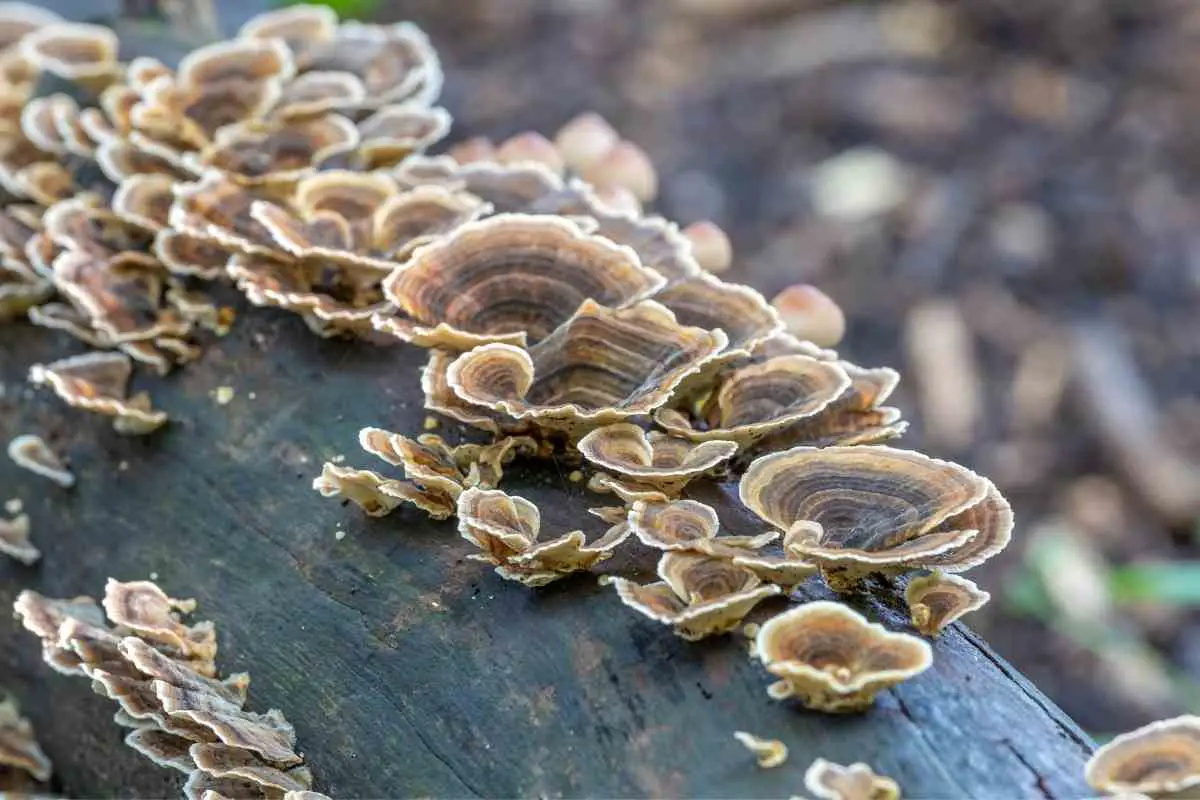Mushrooms: featuring on the plate of many for centuries.
Yet those little button, chestnut, or slightly weirder shiitake mushrooms are not all that’s to be had when it comes to fungi on our plates (or not!).
What’s great about weird mushrooms is their descriptive names!
There’s turkey tail, wood ear, lobster, lion’s mane, devil’s fingers, veiled lady, and bleeding tooth. You can get a great image in your head from the names alone!
Why not read on to find out about some of the weirdest and most wonderful mushrooms on earth – from the divine to the ridiculous!
1. Lobster Mushroom – Hypomyces Lactifluorum
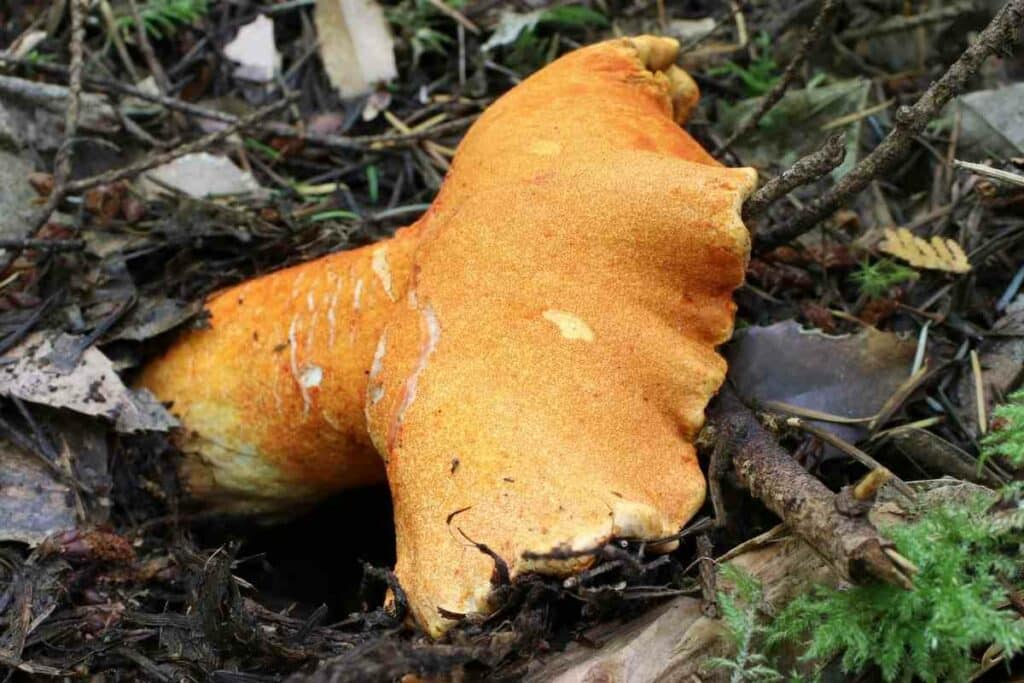
A dish of lobster with a side order of lobster mushroom anyone?
By comparing the two, you sure get an idea about where it got its name!
Where does it grow?
The lobster mushroom is found in North American forests, normally below conifer trees.
To spot the little beauties, it’s best to search in their peak season which is usually from the late summer months until October.
Unique Features
Okay, so we have a confession to make. The lobster mushroom isn’t actually a mushroom! In fact, it’s a parasitic mold.
This delightful parasite attacks other species of mushrooms, engulfing them and altering their appearance to the lovely lobster style we see under those conifers.
They choose their hosts carefully and much prefer the stubby brittle gill mushroom (Russula brevipes).
Useful Properties
We can’t say that there are any particularly useful benefits of this red lobster tail mushroomy delight. However, they can be eaten and are delicious.
If you’re wondering what they taste like, the clue is in the name. Yes, you’ve guessed it – mushroom with a hint of lobster.
In Fact – They’re so much like lobster, they are often used as a substitute in vegetarian “lobster” dishes. It’s a shame that not all weird mushrooms taste this good.
2. Turkey Tail – Trametes Versicolor

The name is the main giveaway – these mushrooms look like turkey’s tails fanning out around the tree trunk.
Where does it grow?
Growing in forests around the world, the turkey tail mushroom grows outwards like a turkey tail and is happy growing on any kind of wood, alive or dead.
Most often, turkey tail grows on tree stumps or fallen logs.
Unique Features
Turkey tail are in the polypore fungi group, a bracket fungus, so named because they grow like shelves or brackets from trees.
They come in different hues – black, grey and rusty brown.
Useful Properties
Turkey tail does have some unique properties as it contains two polysaccharide peptides – PSP and PSK.
Both of these can help increase the number of white blood cells in the body, giving the immune system a boost.
Turkey tail extract is also given to pets by veterinarians. It has quite a chewy texture so is often given to pets in powdered form as a supplement extract.
3. Wood Ear – Auricularia Auricula-Judae
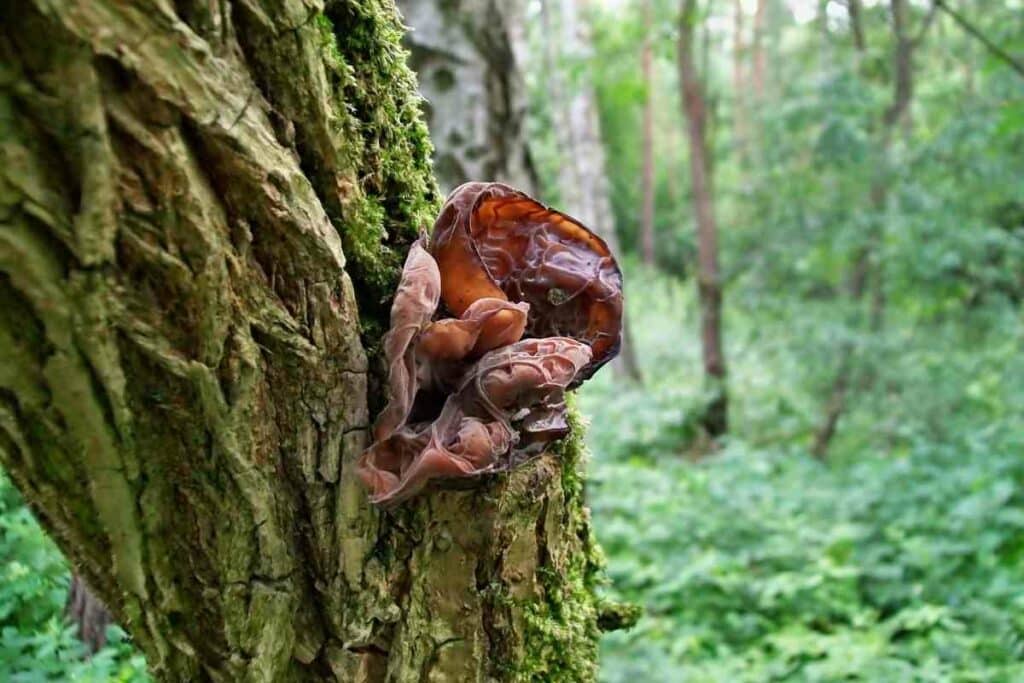
If you’ve not had a sneak peek at the picture, you won’t be surprised to hear that this weird mushroom just looks like a wooden ear!
Where does it grow?
Growing in temperate forests, wood ear mushrooms normally appear in groups on older trees.
They also grow on some living trees including spindle, beech and ash trees.
Unique Features
This mushroom’s uniqueness is certainly in its weird and rather wonderful appearance.
Who wouldn’t want to come across a human-like woody ear in the forest?
Its color ranges from dark brown to translucent (not too dissimilar to the color spectrum of human skin!). Fresh ones also have a rubbery texture.
Useful Properties
Whilst you might not have heard of wood ear mushrooms, traditional Chinese medicine has used them for centuries.
Some would tell you that they can help sore throats and improve breathing when you have a fever or cold.
Some more recent research also shows that this may be the case as they have shown that wood ears contain beta-glucans that might help to strengthen the immune system as well as having antimicrobial properties.
If someone’s chewing your ear off about trying new foods, this one is a good offering.
It doesn’t have a lot of flavor (many have compared it to tofu in that regard), but when added to a dish, they are great flavor absorbers and give soups and stir-fries some added texture.
4. Lion’s Mane – Hericium Erinaceus
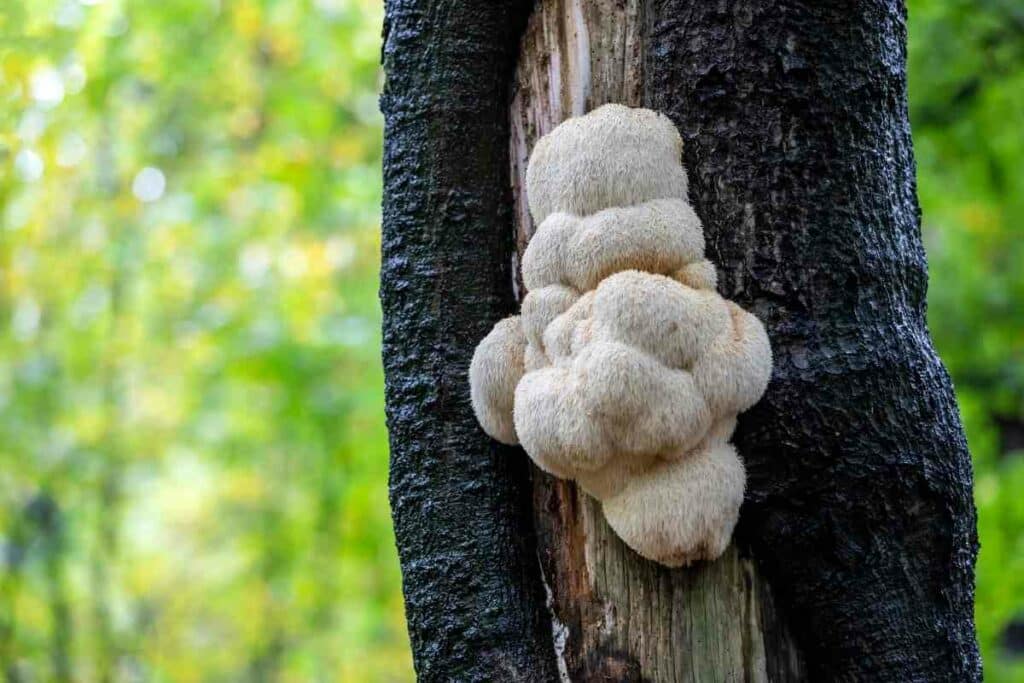
This edible mushroom’s name is also descriptive!
Interestingly, its pseudonyms include the hedgehog mushroom, bearded tooth, monkey head, satyr’s beard, and pompom!
Where does it grow?
Its name doesn’t give any clues as to where this mushroom calls home.
It largely grows on rotting trees in Canada, the Northern United States, Asia and Europe.
Unique Features
This mushroom’s appearance, as you may have deduced, resembles a shaggy lion’s mane.
It is a member of the tooth fungus group of mushrooms as it features ridges that resemble teeth under its caps. The teeth also produce spores.
Useful Properties
The lion’s mane mushroom is believed to be a great adaptogen and helps support the mind and body against stressors in the environment.
Its unique compounds (erinacines and hericenones) may offer protective factors for the body’s neurons. Tests have shown that they can help to enhance focus and improve memory.
Lion’s mane mushrooms are comparable in taste to lobster or crab and are, again, used as a replacement for meat in vegetarian ‘seafood’ dishes.
5. Bleeding Tooth – Hydnellum Peckii
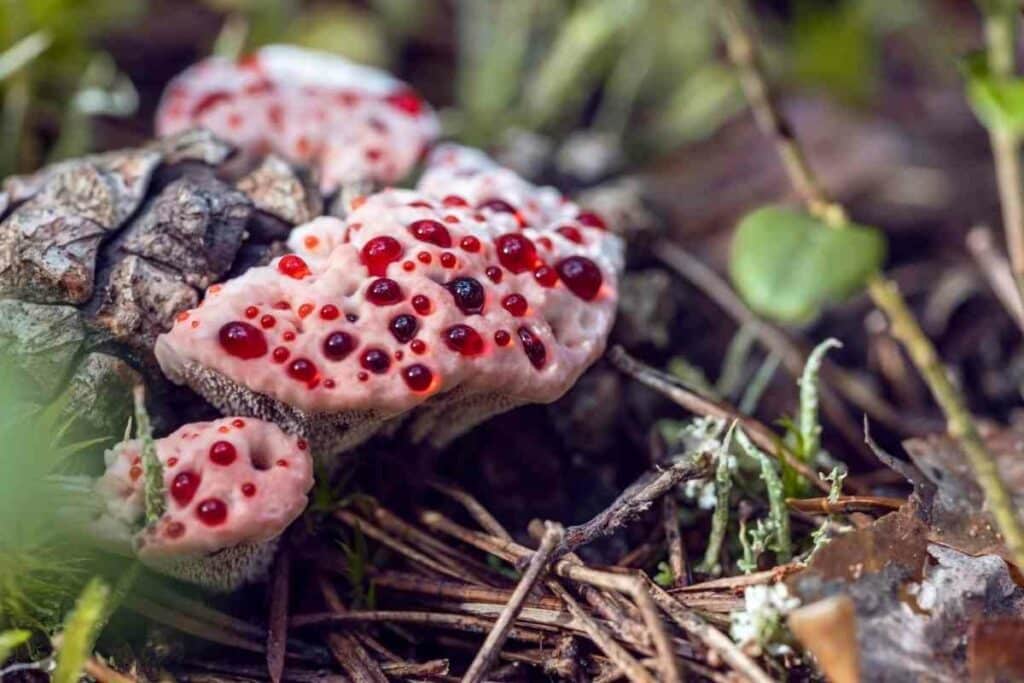
Well, this is a gross sounding (and perhaps looking!) weird mushroom if ever there was one!
Where does it grow?
You will find this mushroom in forest or mountainous areas of Europe, Iran, South Korea and North America.
Like others in its family, it prefers to grow near the roots of conifer trees.
Unique Features
This mushroom is the stuff of nightmares!
Young mushrooms leak a blood-colored sap and, as the mushroom ages, it stops being able to produce the sap and turns a grayish color.
Useful Properties
Aside from looking like it’s from a tooth fairy horror story, the sap from this mushroom actually contains a compound useful in stopping blood clots, called atromentin.
Aside from this, it is used in the textile industry to dye fabric with a natural rather than artificial dye.
Thankfully – This mushroom is rather bitter in taste. If its appearance hasn’t put you off trying it, then the taste just might.
6. Devil’s Fingers – Clathrus Archeri
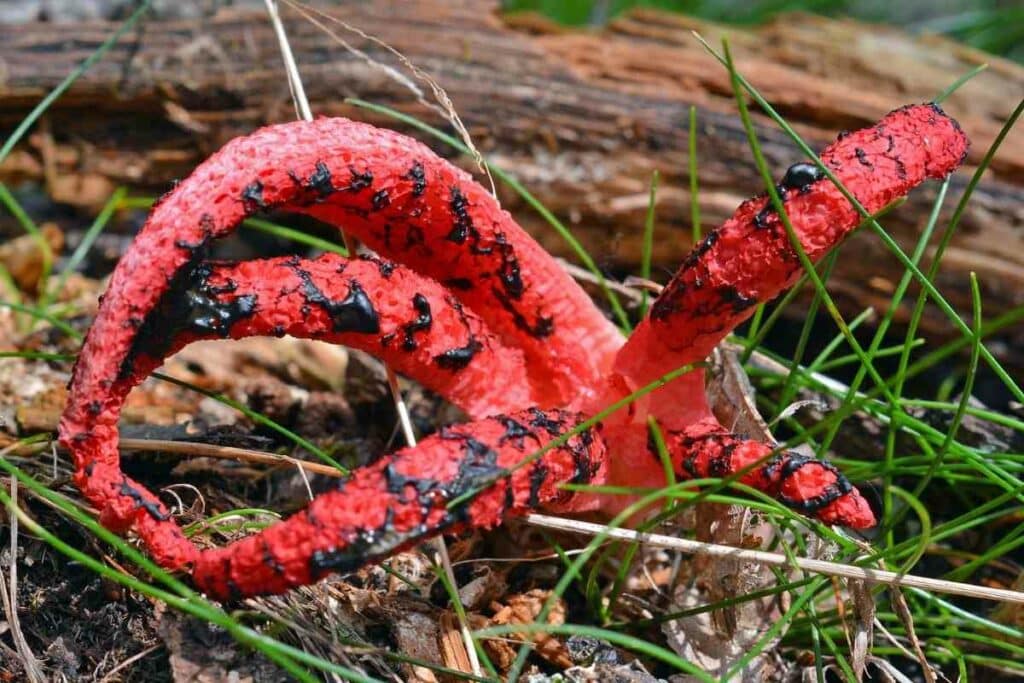
Here we have another mushroom that looks like it’s growing right out of Hallowe’en!
Where does it grow?
This mushroom was originally native to New Zealand and Australia but now grows in other parts of the world too, largely in the South-East hemisphere.
Unique Features
This weird mushroom grows between four and eight finger-like shoots in a bright, bloody red color.
Not only does it look like it’s from the jaws of hell, but it also smells gross thanks to its slimy coating whose scent is akin to that of rotting flesh.
Useful Properties
The devilish scent attracts insects which go on to spread the spores around so that the mushroom reproduces.
Technically, these mushrooms are edible despite their vomitous stench and bitter taste.
7. Veiled Lady – Phallus Indusiatus
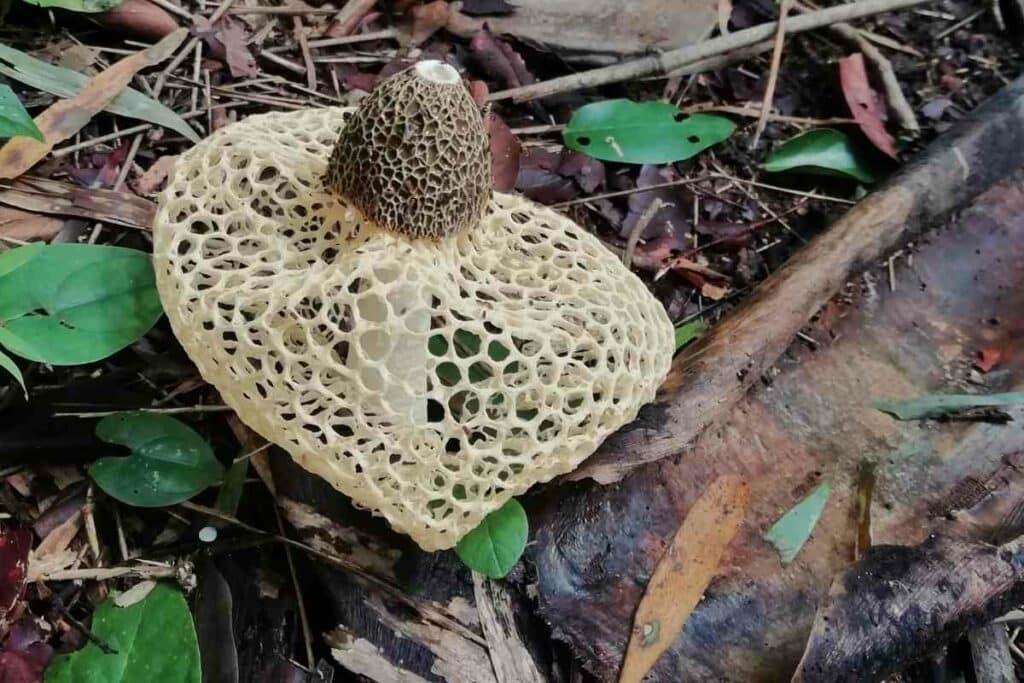
Ah, a pretty looking lady mushroom must smell beautiful, right?
Wrong!
Looks can be deceiving!
Where does it grow?
Growing in most continents, these mushrooms are also called bamboo mushrooms as they like to take up root near bamboo.
Unique Features
The veiled lady mushroom grows in a phallic, upright way (its Latin name gives that much away!).
However, it has a pretty, white lace structure that grows downwards from the cap to the floor. Despite its delicate appearance, it certainly does not smell like a lady – unless she’s decomposing!
This mushroom’s veil isn’t just for decoration.
Like most fancy-looking things in the wild, it’s actually for reproduction, helping insects climb to the top of the mushroom cap where they come into contact with smelly mucus that contains the spores.
They stick to the insects which then spread them around the forest.
Useful Properties
The veiled lady mushroom has been used in traditional Chinese medicine to treat many health conditions.
Researchers are beginning to recognize its potential too. Some studies have shown that it may reduce acid in the human body and could help to promote healthy immune responses.
It’s also considered a delicacy in some Chinese dishes. However, the mushrooms are dried before they are cooked, and the slimy cap is not used.
People describe the taste as both savory and sweet, and it makes a good addition to soups or meat and vegetable dishes.
Final Thoughts on 7 Weirdest Mushrooms
From the bizarre and ‘bleeding’ to the pretty delicate veils, mushrooms across the globe can certainly be weird.
However weird they may be, they’re also fascinating and bring us unusual flavors and medicinal properties.
One thing’s for sure, weird mushrooms have a lot to offer us – much of which we are yet to learn!
